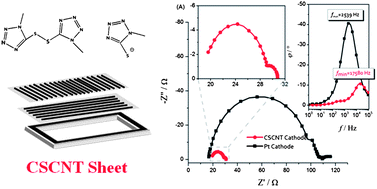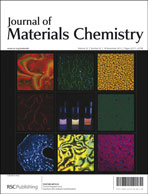Searching for suitable platinum-free electrocatalysts toward novel iodine-free redox couples is of vital importance for further cost reduction and large-scale implementation of dye-sensitized solar cells (DSCs). Herein, cross-stacked superaligned carbon nanotube (CSCNT) sheets were incorporated as efficient economical cathodes in organic disulfide/thiolate redox electrolyte mediated DSCs. Electrochemical characterization revealed that the CSCNT sheets exhibited notably higher electrocatalytic activity toward the disulfide/thiolate redox shuttle over that of ubiquitous platinized cathodes, featuring a significantly decreased charge transfer resistance (ca. 1.26 Ω cm2) and a 4-fold attenuated apparent activation energy (ca. 6.90 kJ mol−1) for disulfide reduction, as well as excellent electrochemical stability. Such a superior electrocatalytic activity was mainly attributed to the synergistic effect of the high specific surface area, relatively open structure for electrolyte accessibility and defect-rich CSCNT cathode. A device incorporating a CSCNT cathode confers a high fill factor of 0.67 and power conversion efficiencies up to 5.81%, which are significantly higher than 0.54 and 4.54% for that with a sputtered Pt cathode. Our investigations demonstrate not only the attractive feasibility of replacing scarce platinum cathodes with abundant carbon materials for novel iodine-free electrolytes, but also the importance of suitable catalyst redox coupling for progress in developing low-cost and high-efficiency DSCs.

You have access to this article
 Please wait while we load your content...
Something went wrong. Try again?
Please wait while we load your content...
Something went wrong. Try again?


 Please wait while we load your content...
Please wait while we load your content...